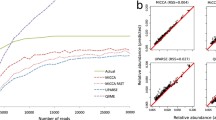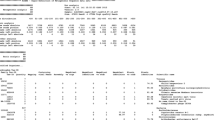Abstract
The rapidly emerging field of metagenomics seeks to examine the genomic content of communities of organisms to understand their roles and interactions in an ecosystem. In this paper we focus on clustering methods and their application to taxonomic analysis of metagenomic data. Clustering analysis for metagenomics amounts to group similar partial sequences, such as raw sequence reads, into clusters in order to discover information about the internal structure of the considered dataset, or the relative abundance of protein families. Different methods for clustering analysis of metagenomic datasets have been proposed. Here we focus on evidence-based methods for clustering that employ knowledge extracted from proteins identified by a BLASTx search (proxygenes). We consider two clustering algorithms introduced in previous works and a new one. We discuss advantages and drawbacks of the algorithms, and use them to perform taxonomic analysis of metagenomic data. To this aim, three real-life benchmark datasets used in previous work on metagenomic data analysis are used. Comparison of the results indicates satisfactory coherence of the taxonomies output by the three algorithms, with respect to phylogenetic content at the class level and taxonomic distribution at phylum level. In general, the experimental comparative analysis substantiates the effectiveness of evidence-based clustering methods for taxonomic analysis of metagenomic data.
Chapter PDF
Similar content being viewed by others
Keywords
These keywords were added by machine and not by the authors. This process is experimental and the keywords may be updated as the learning algorithm improves.
References
Yooseph, S., et al.: The Sorcerer II global ocean sampling expedition: Expanding the universe of protein families. PLoS Biol. 5(3), e16 (2007)
McHardy, A., Rigoutsos, I.: What’s in the mix: phylogenetic classification of metagenome sequence samples. Current Opinion in Microbiology 10, 499–503 (2007)
Raes, J., Foerstner, K., Bork, P.: Get the most out of your metagenome: computational analysis of environmental sequence data. Current Opinion in Microbiology 10, 490–498 (2007)
Li, W., Wooley, J., Godzik, A.: Probing metagenomics by rapid cluster analysis of very large datasets. PLoS One 3(10) (2008)
Dalevi, D., Ivanova, N., Mavromatis, K., Hooper, S., Szeto, E., Hugenholtz, P., Kyrpides, N., Markowitz, V.: Annotation of metagenome short reads using proxygenes. Bioinformatics 24(16) (2008)
Pop, M., Phillippy, A., Delcher, A., Salzberg, S.: Comparative genome assembly. Briefings in Bioinformatics 5(3), 237–248 (2004)
Chan, C., Hsu, A., Tang, S., Halgamuge, S.: Using growing self-organising maps to improve the binning process in environmental whole-genome shotgun sequencing. Journal of Biomedicine and Biotechnology (2008)
Folino, G., Gori, F., Jetten, M.S.M., Marchiori, E.: Clustering metagenome short reads using weighted proteins. In: EvoBIO 2009. LNCS, vol. 5483, pp. 152–163. Springer, Heidelberg (2009)
Korf, I., Yandell, M., Bedell, J.: BLAST. O’Reilly & Associates, Inc., Sebastopol (2003)
Madden, T.: 16. In: The BLAST Sequence Analysis Tool, Bethesda, MD (2002)
Altschul, S., Gish, W., Miller, W., Myers, E., Lipman, D.: Basic local alignment search tool. J. Molecular Biology 215(3), 403–410 (1990)
Marchiori, E., Steenbeek, A.: An evolutionary algorithm for large scale set covering problems with application to airline crew scheduling. In: Oates, M.J., et al. (eds.) EvoIASP 2000, EvoWorkshops 2000, EvoFlight 2000, EvoSCONDI 2000, EvoSTIM 2000, EvoTEL 2000, and EvoROB/EvoRobot 2000. LNCS, vol. 1803, pp. 367–381. Springer, Heidelberg (2000)
Biddle, J.F., et al.: Metagenomic signatures of the Peru margin subseafloor biosphere show a genetically distinct environment. PNAS (105), 10583–10588 (2008)
Venter, J., et al.: Environmental genome shotgun sequencing of the sargasso sea. Science (304), 66–74 (2004)
Author information
Authors and Affiliations
Editor information
Editors and Affiliations
Rights and permissions
Copyright information
© 2009 Springer-Verlag Berlin Heidelberg
About this paper
Cite this paper
Folino, G., Gori, F., Jetten, M.S.M., Marchiori, E. (2009). Evidence-Based Clustering of Reads and Taxonomic Analysis of Metagenomic Data. In: Kadirkamanathan, V., Sanguinetti, G., Girolami, M., Niranjan, M., Noirel, J. (eds) Pattern Recognition in Bioinformatics. PRIB 2009. Lecture Notes in Computer Science(), vol 5780. Springer, Berlin, Heidelberg. https://doi.org/10.1007/978-3-642-04031-3_10
Download citation
DOI: https://doi.org/10.1007/978-3-642-04031-3_10
Publisher Name: Springer, Berlin, Heidelberg
Print ISBN: 978-3-642-04030-6
Online ISBN: 978-3-642-04031-3
eBook Packages: Computer ScienceComputer Science (R0)





